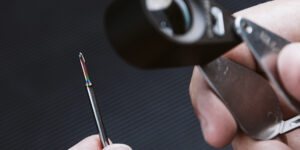Inverter-Based Welding Machines Provide Flexibility and Ease of Use
ESAB’s new welder uses inverter technology, which delivers significantly increased energy efficiency and superior functionality in a package that is lighter and smaller than an old SCR technology machines and competitively priced versus other AC/DC inverters.
Posted: December 9, 2013
ESAB Welding & Cutting Products (Florence, SC) introduced the new Heliarc family of inverter-based welding machines for AC/DC GTAW (TIG) and SMAW (Stick) welding at FABTECH 2013. Heliarc provides superior TIG and outstanding Stick performance, including cellulosic (E-XX10, E-XX11) electrodes. Three Heliarc models comprise the new product line.
The system uses inverter technology, which delivers significantly increased energy efficiency and superior functionality in a package that is lighter and smaller than an old SCR technology machines and competitively priced versus other AC/DC inverters. Easy-to-achieve, optimized arc settings enable the operator to weld aluminum using a pointed tungsten.
The tungsten remains pointed improving arc starts, heat input and arc stability, thus assuring high quality welds. Heliarc’s pulse current allows for smaller HAZ (Heat Affect Zone), better control of the weld pool, and less plate deformation.
In AC GTAW mode, the power source uses high frequency (HF) only to initiate the arc, compared to older power source technology which requires HF to be continuous. Heliarc’s fast switching AC process removes the need for HF during welding, reducing electrical noise and the risk of interference to surrounding electronics. High frequency can be switched off in favor of ESAB’s live TIG arc start method when welding in areas where high frequency is not permitted.
Enhanced AC balance controls provide significantly improved cleaning or penetration compared to conventional AC/DC power sources. Heliarc provides an AC frequency control which focuses the arc for narrow weld beads and faster travel speed. Reducing the weld bead has significant advantages in reducing cost, as well as in reducing welding consumable and arc time, resulting in improved efficiency and operating profit.
The welder also features AC Pulse (GTAW) TIG from 0.4 up to 2 Hz ideal for welding thin aluminum. High speed DC pulse GTAW (TIG) provides a smooth welding output which is precisely controlled to deliver faster travel speeds and more penetration. Increasing the pulses per second also improves arc stability and perfects interfusion between base and filler material.
Heliarc’s control panel is easy to setup and operate. Five clear, logical work zones on the control panel allow the operator to choose the options and settings needed for fast set up and excellent arc control. The machine’s internal communication is entirely digital for high accuracy and repeatability.
All controls are centrally located. Easy-to-use buttons provide slope down, pulse current, background current, pre-gas, post-gas, pulse and duty options. The machine’s memory can store and recall up to 60 user-defined welding programs.
Operators have the flexibility to choose between Stick, TIG 2- and 4-stroke mode (trigger latch), TIG spot, and trigger-enabled peak to background current, which can be used as a manual pulse to decrease heat input and control puddle fluidity while welding. In stick mode, the submenu allows for access to adjustable Hot Start and Arc Force settings.
Three Heliarc models comprise the new product family, including the Heliarc 281i, a 280 Amp unit for single-phase 230 connections; the Heliarc 283i, a 280 Amp unit for 3-phase 460 connections; and the Heliarc 353i, a 350 Amp 3-phase 460 unit for increased power when welding thicker materials.
The Heliarc 281i and 283i (460V only) are available as ready-to-weld air-cooled and water- cooled packages and include the power source, 25 foot torch, foot control, work cable, regulator flowmeter (ArCo2), and cart. The Heliarc 353i (460V only) is available in a water-cooled ready-to-weld package and includes the power source, cooler, 25 foot torch, foot control, work cable, regulator flowmeter (ArCo2), and cart.














